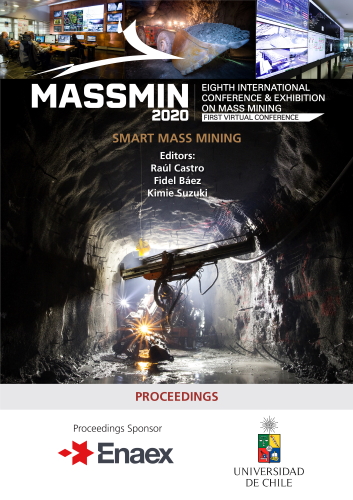The design & operating philosophies of panel vs block caving

|
Authors: van As, A; Guest, A |
This paper is hosted with the kind permission of Lulea University of Technology, International Conference & Exhibition on Mass Mining, 2024.
DOI https://doi.org/10.36487/ACG_repo/2063_10
Cite As:
van As, A & Guest, A 2020, 'The design & operating philosophies of panel vs block caving', in R Castro, F Báez & K Suzuki (eds), MassMin 2020: Proceedings of the Eighth International Conference & Exhibition on Mass Mining, University of Chile, Santiago, pp. 207-220, https://doi.org/10.36487/ACG_repo/2063_10
Abstract:
The modern trend of designing large underground cave mines according to their desired production throughput rather than utilizing appropriate, geotechnically driven mine design parameters, has caused considerable confusion and ultimately, culminated in poor cave performance. There is a growing tendency for caves with large footprints to be designed as panel caves regardless of their Footprint to Block height ratio. The misconception that a “panel cave” with high block height (Block height / Footprint >2) can be designed and operated no differently to that of a conventional panel cave, with smaller block height (Block height / Footprint < 2) has led to numerous geotechnical problems, including; poor cave propagation and adverse cave shape resulting in ore losses, early dilution entry, large fragmentation, ore recompaction and point loading of the extraction level, to name but a few. This paper serves to define and describe the fundamental design and operating philosophies that are characteristic of successful block and panel caves and highlights the dangers of mixing the two. It further offers an alternative for these horizontal cave layouts, namely the incline cave layout.
References:
Araneda, O & Sougarret, A 2008, ‘Lessons learned in cave Mining: El Teniente 1997-2007’, in H Schunnesson & E Nordlund (eds), Proceedings of MassMin 2008, 9-11 June, Lulea, Sweden. pp. 43-52.
Diering, T 2014, ‘Reserve Estimation for Block Cave Mines Using PCBC.’, Mineral Resource and Ore Reserve Estimation – The AUSIMM Guide to good practice. Second edition, Monograph 3. AusIMM, Carlton, Victoria, pp. 542-555.
Diering, T 2008, ‘Block cave scheduling with a piece of paper’, in H Schunnesson & E Nordlund (eds), Proceedings of MassMin 2008, 9-11 June, Lulea, Sweden, pp. 303-508.
Dudley, JA 2014, ‘Block Caving Software - Practical Applications’, Mineral Resource and Ore Reserve Estimation – The AUSIMM Guide to good practice, Second edition, Monograph 3. AusIMM, Carlton, Victoria, pp. 535-546.
Flores, G & Catalan, A 2019, ‘A transition from a large open pit into a novel “macroblock variant” block caving geometry at Chuquicamata mine, Codelco Chile’, Journal of Rock Mechanics and Geotechnical Engineering, vol.11, no. 3, June 2019, pp. 549-561.
Flores, G E 2005, ‘Rock mass response to the transition from open pit to underground cave mining’, PhD thesis (unpublished), University of Queensland, Brisbane.
Hormazabal, E, Villegas, F, Rovira, F & Carranza-Torres, C 2010, ‘Geomechanical evaluation of macro-block caving options using 3D numerical modelling at Chuquicamata underground project in Chile’, in Y Potvin (ed.), Proceedings of the Second International Symposium on Block and Sublevel Caving, Australian Centre for Geomechanics, Perth, pp. 469-482.
Hudyma,M, Allison, D & Potvin, E, 2008a, ‘Seismic monitoring of the Northparkes Lift 2 block cave - Part 1 production caving’, Journal- South African Institute of Mining and Metallurgy, vol. 108, no. 7, pp. 421-430.
Hudyma,M, Allison, D & Potvin, E, 2008b, ‘Seismic monitoring of the Northparkes Lift 2 block cave - Part 1 production caving’, Journal- South African Institute of Mining and Metallurgy, vol. 108, no. 7, pp.421-430.
Laubscher, DH, Guest, AR & Jakubec, J 2017, ‘Guidelines on Caving Mining Methods; The Underlying Concepts’. JK Publications, The University of Queensland, Australia.
Laubscher, DH, 2000, ‘Block Caving Manual’, International Caving Study. JKMRC and Itasca Consulting Group, Inc, Brisbane.
Laubscher, DH, 1994, ‘Cave mining – the state of the art’, Journal of the South African Institute of Mining Metallurgy, 94(10), Johannesburg, pp. 279-293.
Laubscher, DH & Esterhuizen, GS, 1994, ‘Inclined drawpoint caving – a cave-mining method’. Proceedings XVth Commonwealth Mining and Metallurgical Institutions Congress, South African Institute of Mining and Metallurgy and Geological Society of South Africa: Johannesburg, pp. 247-250.
Laubscher, DH, 1981, ‘Selection of underground mass mining methods’, D R Stewart (ed.), Design and Operation of Caving and Sublevel Stoping Mines, Society of Mining Engineers, AIME: New York, pp. 23-38.
Lett, JL, Brunton, I, Capes, GW, Jäger, A, Mobilio, B, Rachocki, J, Sharrock, GB & Secheny, M 2016, ‘Undercutting to surface breakthrough – Cadia East Panel Cave (Stage 1)’, in C Carr & G Chitombo (eds), Proceedings of MassMin 2016, Melbourne, Australia, pp. 65–82.
Richardson, MP 1981, ‘Area of draw influence and drawpoint spacing for block caving mines’, D R Stewart (ed.), Design and Operation of Caving and Sublevel Stoping Mines, Society of Mining Engineers, AIME: New York, pp 149-156.
Ross, I 2008, ‘Northparkes E26 Lift 2 block cave – A case study’, in H Schunnesson & E Nordlund (eds), Proceedings of MassMin 2008, 9-11 June, Lulea, Sweden, pp. 25-34.
Susaeta, A, Rubio, E, Henríquez, J & País, G 2008, ‘Dilution behaviour at Codelco panel cave mines’, in C Carr & G Chitombo (eds), Proceedings of MassMin 2016, 9-11 June, Lulea, Sweden, Lulea, Sweden, pp. 167 – 178.
Susaeta, A, 2004, ‘Theory of gravity flow (Part 1)’, in A Karzulovic & M.Alfaro (eds), Proceedings of MassMin 2004, Santiago, pp. 167-172.
Vera, SG 1981, ‘Caving at Climax. Chapter 14’, D R Stewart (ed.), Design and Operation of Caving and Sublevel Stoping Mines, Society of Mining Engineers, AIME: New York, pp 157-176.
Ward, MH 1981, ‘Technical and economical considerations of the block caving mine’, D R Stewart (ed.), Design and Operation of Caving and Sublevel Stoping Mines, Society of Mining Engineers, AIME: New York.
© Copyright 2025, Australian Centre for Geomechanics (ACG), The University of Western Australia. All rights reserved.
View copyright/legal information
Please direct any queries or error reports to repository-acg@uwa.edu.au
View copyright/legal information
Please direct any queries or error reports to repository-acg@uwa.edu.au
